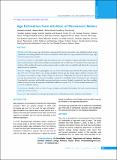Please use this identifier to cite or link to this item:
https://hdl.handle.net/20.500.14356/1066Full metadata record
| DC Field | Value | Language |
|---|---|---|
| dc.contributor.author | Subedi, Nuwadatta | - |
| dc.contributor.author | Mallik, Mukesh | - |
| dc.contributor.author | Chaudhary, Roshan Kumar | - |
| dc.contributor.author | Gurung, Gita | - |
| dc.date.accessioned | 2023-04-21T06:08:39Z | - |
| dc.date.available | 2023-04-21T06:08:39Z | - |
| dc.date.issued | 2021 | - |
| dc.identifier.citation | SubediN., MallikM., ChaudharyR. K., & GurungG. (2021). Age Estimation from Attrition of Permanent Molars. Journal of Nepal Health Research Council, 19(1), 101-106. https://doi.org/10.33314/jnhrc.v19i1.3397 | en_US |
| dc.identifier.issn | Print ISSN: 1727-5482; Online ISSN: 1999-6217 | - |
| dc.identifier.uri | http://103.69.126.140:8080/handle/20.500.14356/1066 | - |
| dc.description | Original Article | en_US |
| dc.description.abstract | Abstract Background: The average stage of attrition in permanent first and second molars is an established method of age estimation in the adult population. The study was conducted with an objective of age estimation from the average stage of attrition of permanent molars. Methods: A total of 451 individuals of age more than 20 years were examined. Nepalese individuals with intact first and second permanent molars in the maxillary and mandibular arch on either side were included. The average stage of attrition of the maxillary first and second permanent molars on either side was calculated and subjected to regression analysis to derive equations. Results: Among a total of 451 participants, 231 (51.22%) were females and 220 (48.78%) males, with a mean age of 44.3 ± 13.9 years. There was a strong correlation between age and average stage of attrition of molars. The correlation was stronger for upper molars compared to the lowers. Additionally, the mean of the difference between real age and estimated age was lower for maxillary compared to mandibular molars. Compared to age estimation by univariable regression, multivariable regression had greater accuracy. Similarly, estimation of age from maxillary molars was more accurate as compared to mandibular (difference in years: 3.82 ± 3.03 for maxillary molars and 5.17 ± 4.2 for mandibular molars). Conclusions: Maxillary teeth are better for age estimation and using both maxillary first and second permanent molars gives better accuracy. Keywords: Age estimation by teeth; age reporting; forensic anthropology; forensic dentistry; tooth attrition | en_US |
| dc.language.iso | en | en_US |
| dc.publisher | Nepal Health Research Council | en_US |
| dc.relation.ispartofseries | Jan-March, 2021;3397 | - |
| dc.subject | Age estimation by teeth | en_US |
| dc.subject | age reporting | en_US |
| dc.subject | forensic anthropology | en_US |
| dc.subject | forensic dentistry | en_US |
| dc.subject | tooth attrition | en_US |
| dc.title | Age Estimation from Attrition of Permanent Molars | en_US |
| dc.type | Journal Article | en_US |
| local.journal.category | Original Article | - |
| Appears in Collections: | Vol. 19 No. 1 (2021): Vol. 19 No. 1 Issue 50 Jan-Mar 2021 | |
Files in This Item:
| File | Description | Size | Format | |
|---|---|---|---|---|
| 3397-Manuscript-21558-1-10-20210425.pdf | Fulltext Download | 484.15 kB | Adobe PDF |  View/Open |
Items in DSpace are protected by copyright, with all rights reserved, unless otherwise indicated.
